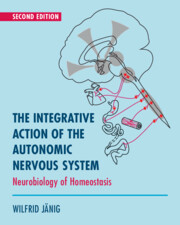Book contents
- The Integrative Action of the Autonomic Nervous System
- Reviews
- The Integrative Action of the Autonomic Nervous System
- Copyright page
- Dedication
- Contents
- Foreword to the Second Edition
- Foreword to the First Edition
- Preface
- Abbreviations
- Introduction The Autonomic Nervous System and the Regulation of Body Functions
- Part I The Autonomic Nervous System: Functional Anatomy and Interoceptive Afferents
- Part II Functional Organization of the Peripheral Autonomic Nervous System
- Part III Transmission of Signals in the Peripheral Autonomic Nervous System
- Part IV Representation of the Autonomic Nervous System in the Spinal Cord and Lower Brain Stem
- Part V The Centers of Homeostasis in the Mesencephalon and Hypothalamus and Their Telencephalic Control
- Index
- References
Introduction - The Autonomic Nervous System and the Regulation of Body Functions
Published online by Cambridge University Press: 16 July 2022
- The Integrative Action of the Autonomic Nervous System
- Reviews
- The Integrative Action of the Autonomic Nervous System
- Copyright page
- Dedication
- Contents
- Foreword to the Second Edition
- Foreword to the First Edition
- Preface
- Abbreviations
- Introduction The Autonomic Nervous System and the Regulation of Body Functions
- Part I The Autonomic Nervous System: Functional Anatomy and Interoceptive Afferents
- Part II Functional Organization of the Peripheral Autonomic Nervous System
- Part III Transmission of Signals in the Peripheral Autonomic Nervous System
- Part IV Representation of the Autonomic Nervous System in the Spinal Cord and Lower Brain Stem
- Part V The Centers of Homeostasis in the Mesencephalon and Hypothalamus and Their Telencephalic Control
- Index
- References
Summary
All living organisms interact continuously with their environment. They receive multiple signals from the environment via their sensory systems and respond by way of their somatomotor system. Both sensory processing and motor actions are entirely under the control of the central nervous system. The brain represents the extracorporeal space, the somatic body domains, the executive motor programs and programs for the diverse patterns of behavior initiated from higher centers. It generates complex motor commands on the basis of these central representations leading to movements of the body in its environment against different internal and external forces. The tools for performing these actions are the effector machines, the skeletal muscles and their controlling somatomotoneurons.
- Type
- Chapter
- Information
- The Integrative Action of the Autonomic Nervous SystemNeurobiology of Homeostasis, pp. 1 - 6Publisher: Cambridge University PressPrint publication year: 2022

